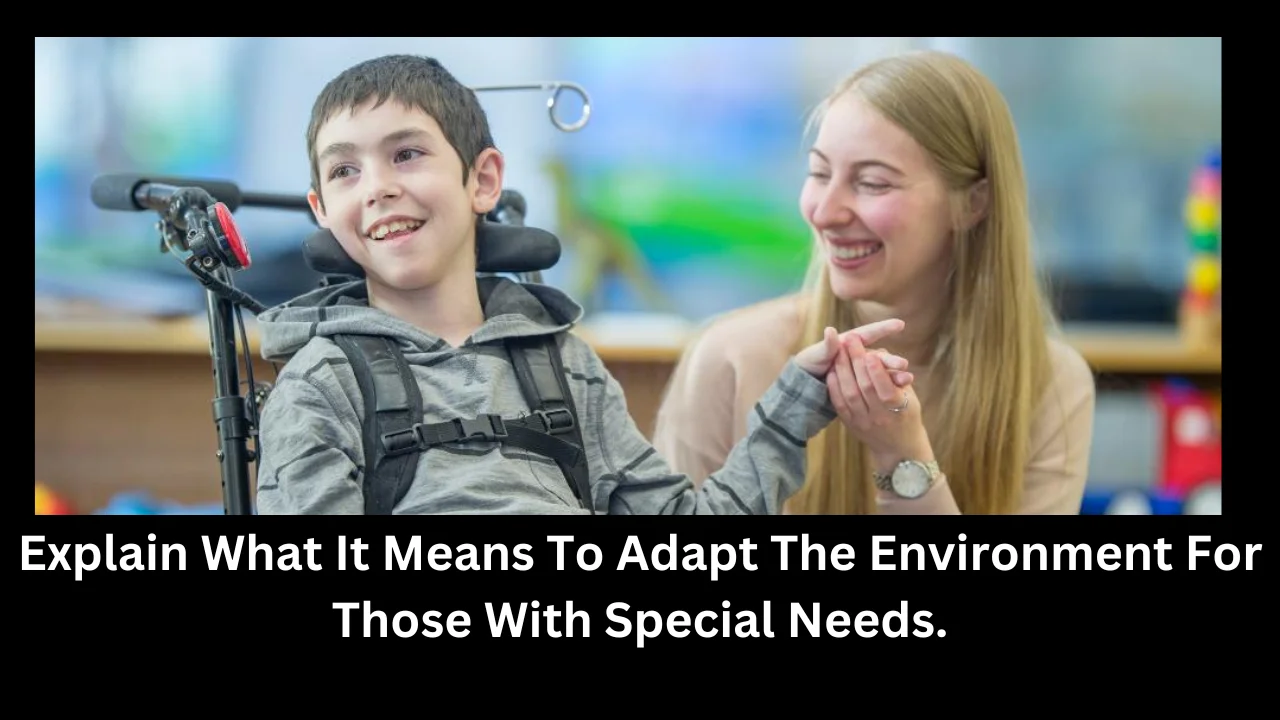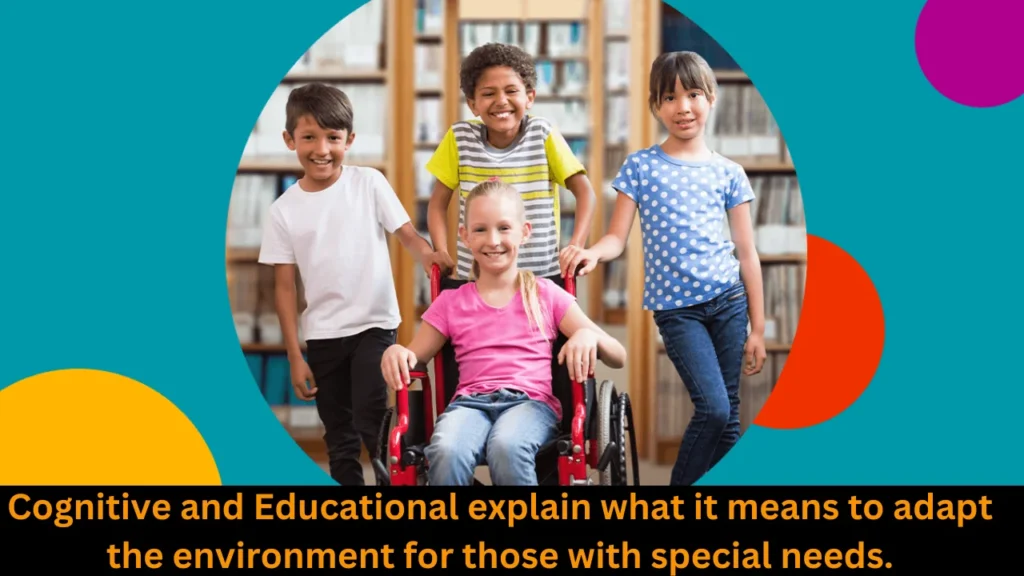Explain What It Means To Adapt The Environment For Those With Special Needs.

Adapting the environment for individuals with special needs involves creating a space that enhances their ability to thrive and succeed. This process encompasses physical, sensory, and cognitive adjustments tailored to specific requirements, ensuring inclusivity and accessibility in various settings such as schools, workplaces, and public areas. When we explain what it means to adapt the environment for those with special needs. it’s crucial to focus on the aspects that can positively impact their daily lives and overall well-being.
What is explain what it means to adapt the environment for those with special needs.
Adapting the environment for those with special needs involves modifying physical spaces, educational settings, and social structures to ensure accessibility, inclusion, and support for individuals with disabilities. This can include changes such as installing ramps for wheelchair users, using sensory-friendly materials for those with sensory processing disorders, or implementing individualized educational plans (IEPs) for students with learning disabilities. The goal is to create environments that allow individuals with special needs to engage, learn, and participate fully in their communities, promoting independence and equal opportunities.
What Does Adapting the Environment Entail
To explain what it means to adapt the environment for those with special needs, one must consider modifications that cater to the diverse range of disabilities, including physical, developmental, and emotional. These adaptations can be as simple as installing ramps for wheelchair users or as complex as designing specialized educational programs for children with learning disabilities. The goal is to minimize barriers and provide an environment that promotes independence and participation.
Physical Modifications for Accessibility
Physical adaptations are among the most visible forms of environmental modification. They include:
Installing Ramps and Elevators:
These structures ensure that individuals who use wheelchairs or have mobility issues can access buildings and navigate different floors comfortably.
Widening Doorways:
This allows for easier movement of wheelchairs and other mobility aids.
Adjustable Furniture:
Desks and workstations that can be adjusted in height are beneficial for individuals who need to use mobility devices or have specific physical needs.
These changes, though often straightforward, play a vital role in making spaces accessible to everyone. When you explain what it means to adapt the environment for those with special needs, it’s important to emphasize that these modifications are not just conveniences but necessities for equal access and participation.
Sensory Adjustments for Better Learning and Comfort
Sensory adaptations are crucial for individuals with sensory processing disorders, autism, or ADHD. These adjustments help create a comfortable and conducive environment that reduces overstimulation or under-stimulation.
Lighting Adjustments:
Using soft, natural lighting instead of harsh fluorescent lights can significantly reduce discomfort for those sensitive to bright lights.
Soundproofing:
Reducing noise levels in classrooms or offices helps individuals who are easily distracted or overwhelmed by sound.
Sensory Rooms:
These are specialized spaces equipped with calming lights, sounds, and textures that help individuals relax and manage sensory overload.
By integrating these sensory adjustments, we can explain what it means to adapt the environment for those with special needs by showing how such environments support emotional regulation and focus.
Cognitive and Educational explain what it means to adapt the environment for those with special needs.

For individuals with learning disabilities or cognitive impairments, adapting the educational environment is essential. This involves tailored teaching strategies and the use of assistive technologies to support learning.
Visual Aids and Symbols:
Using images, symbols, and visual schedules helps individuals with communication difficulties understand and follow instructions.
Assistive Technology:
Devices such as text-to-speech software or communication boards enable students to interact and learn more effectively.
Individualized Education Plans (IEPs):
These customized plans ensure that educational content and teaching methods are adapted to meet the unique learning needs of each student.
Such adaptations demonstrate a commitment to inclusive education, ensuring that all students have the opportunity to succeed. When you explain what it means to adapt the environment for those with special needs, these educational strategies are crucial in highlighting how learning environments can be made more inclusive and supportive.
Social and Emotional Environment Adaptations
Creating a supportive social and emotional environment is as important as physical and cognitive adaptations. This involves fostering a culture of acceptance, understanding, and inclusion.
Peer Support Programs:
These initiatives encourage interactions between students with and without disabilities, promoting friendship and understanding.
Training for Staff and Peers:
Educating staff and peers about various disabilities and how to support individuals effectively helps build a more inclusive community.
Anti-Bullying Policies:
Strict policies against bullying and discrimination ensure that individuals with special needs feel safe and respected.
These social adaptations are vital when we explain what it means to adapt the environment for those with special needs because they focus on the emotional well-being and social integration of individuals, making them feel valued and included.
Legal and Policy Framework Supporting Adaptations
Understanding the legal aspects of adapting environments for special needs is crucial. Laws and policies like the Americans with Disabilities Act (ADA) and the Individuals with Disabilities Education Act (IDEA) play a significant role in promoting accessibility and inclusion.
Americans with Disabilities Act (ADA):
This law ensures that public spaces and workplaces are accessible to individuals with disabilities, mandating necessary modifications.
Individuals with Disabilities Education Act (IDEA):
This policy ensures that students with disabilities receive free and appropriate public education in the least restrictive environment.
These frameworks not only protect the rights of individuals with disabilities but also guide institutions and organizations in making necessary adaptations. When we explain what it means to adapt the environment for those with special needs, acknowledging these legal supports is essential to understanding the broader context of accessibility and inclusion.
| Type of Need | Adaptation Examples | Purpose |
|---|---|---|
| Physical Disabilities | Ramps, wide doorways, adjustable furniture | Enable mobility and access |
| Sensory Processing Disorders | Soft lighting, soundproofing, sensory rooms | Reduce sensory overload, promote comfort |
| Learning Disabilities | Visual aids, assistive technology, IEPs | Enhance learning, support communication |
| Social and Emotional Support | Peer programs, staff training, anti-bullying policies | Foster inclusion, provide emotional security |
The Role of Technology in Adapting Environments
Technology plays a transformative role in adapting environments for those with special needs. From communication devices to virtual reality (VR) tools, technology enables individuals to overcome various barriers.
Communication Devices:
These include tablets with speech-generating applications, allowing non-verbal individuals to communicate effectively.
Virtual Reality (VR) Tools:
VR can simulate real-world scenarios, helping individuals practice social interactions or learn new skills in a safe environment.
Adaptive Software:
Programs like screen readers and voice recognition software help individuals with visual or motor impairments use computers and access information.
Integrating technology into adaptations can significantly enhance the quality of life for individuals with special needs. When we explain what it means to adapt the environment for those with special needs, technology’s role is crucial in bridging gaps and creating opportunities.
Why Adapting the Environment Matters
Creating environments that are accessible and inclusive is not just about compliance; it’s about promoting dignity, independence, and equal opportunity. When you explain what it means to adapt the environment for those with special needs, you highlight the importance of enabling individuals to participate fully in all aspects of life. This commitment to inclusivity benefits everyone, fostering a more diverse and accepting society.
Frequently Asked Questions
What are some common adaptations for individuals with special needs?
Common adaptations include installing ramps, widening doorways, using assistive technology, creating sensory-friendly environments, and implementing tailored educational plans.
How can schools adapt to support students with special needs?
Schools can adapt by offering individualized education plans (IEPs), using visual aids, providing specialized teaching strategies, and ensuring accessible facilities.
Why is it important to adapt environments for those with special needs?
Adapting environments promotes inclusivity, independence, and equal opportunities, allowing individuals with special needs to fully participate in their communities and lead fulfilling lives.
Conclusion
To explain what it means to adapt the environment for those with special needs. for those with special needs is to recognize the diverse requirements of individuals and to actively work towards creating spaces that accommodate these needs. Whether through physical modifications, sensory adjustments, or educational supports, these adaptations empower individuals to live more independently and participate meaningfully in their communities.






